Marcia Thornton Jones's Blog, page 6
June 1, 2025
News
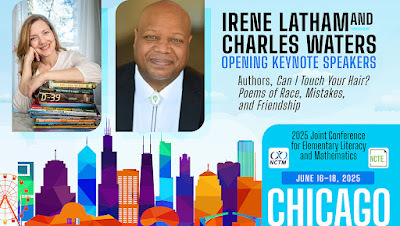
Irene Latham and Charles Waters look forward to meeting you in Chicago at the 2025 Joint Conference for Elementary Literacy and Mathematics, June 16-18, 2025.
May 28, 2025
Look At It From A Different Point of View
by Charlotte Bennardo
Everyone knows the art of MC Escher:
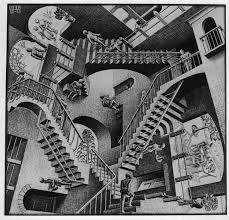
https://images.app.goo.gl/P5Bw7ggz8kS...
As a kid, I was fascinated by among all of them, this drawing, trying to figure out a way to climb all the stairs. Hint: it's impossible unless you CHANGE YOUR PERSPECTIVE.
And that is what life, art, and situations demand of us; sometimes we have to change our perspective in order to see a different view of the picture.
When it comes to reading outside our comfort zone, whether young reader or mature, it's hard to change that perspective. For me, it's reading non-fiction. Life is messy and hard and emotionally exhausting. WHY would I want to read about others' struggles or pain?
Yet, every once in a while, I take the leap, to see a different perspective, a different view. The last non-fiction book I read (gifted to me by a nice woman poolside in Mexico), was A Serial Killer's Daughter: My Story of Hope, Love, and Overcoming, by Kerri Rawson. Her father was the BTK Killer. Talk about the most radical departure from my usual reading! The only reasons I read it were that my Canadian poolside companion assured me there were no gory details about her father's horrific path of murder, it ended on a positive personal affirmation, and it gave a unique perspective into how monsters can hide in plain sight and not even family members see the evil. It was eye-opening.
And that's what we sometimes need; to have our eyes opened, to see something differently. And although we resist, it's a good lesson,to try a different stairway. Guess Escher knew this before the rest of us figured it out.
Char
Charlotte writes MG, YA, NA, and adult novels in sci fi, fantasy, contemporary, paranormal and romance genres. Her latest YA fantasy novel, The Excalibur Vow, just released. She is the author of the award-winning middle grade Evolution Revolution trilogy, Simple Machines, Simple Plans, and Simple Lessons. She co-authored the YA novels Blonde OPS, Sirenz, and Sirenz Back in Fashion. She has several short stories in the various anthologies. Having finished her MFA, she's applying what she learned and is working on several children's and adult novels, and other short stories. She lives in NJ with her family and floofy cat Mink, a squirrel in the backyard tree, and a visiting pet rabbit Bad Bunny.
May 25, 2025
A Change of Perspective (Holly Schindler)
Art is becoming an increasingly bigger part of my life.
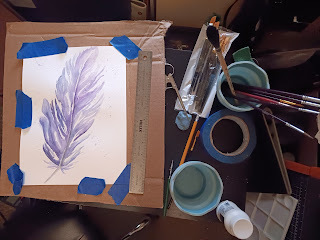 Work in progress: A watercolor feather. First time I've used watercolor in this century.
Work in progress: A watercolor feather. First time I've used watercolor in this century. This has been happening for the past ten years or so.
I mean, art was an enormous part of my life when I was younger. In high school, I took every single art class my school offered. I worked the All-School Art Exhibits at the Springfield Art Museum. My college application to then-SMSU was as a prospective art major.
When I switched to all things English, I left art behind.
And then, about ten years ago, I started publishing some work of my own. To do that, I had to create covers. Design interiors.
And the itch to get back to art started.
A couple of years ago (inspired by Carrie Jones's Be Brave Friday series on social media and a few design IG videos from @heyalissandra), I bought an iPad. My art skills had completely stalled where I was when I was eighteen, so I got a Skillshare subscription. I bought online art courses. I finally dug in and learned Illustrator. I learned how to make patterns and greeting cards.
This past Christmas, I got a ton of art supplies. I just got my office cleaned out so that I can move the supplies in.
I'm now learning to use my watercolors. And let me tell you, there is something about drawing and painting that changes how your mind works. Doesn't matter how good the art is. It's the process of learning to translate something visually onto the page. It changes what you see. It changes your perspective. It changes how you write. Because it changes what you see as possible.
~
Holly Schindler is the author of The Junction of Sunshine and Lucky
May 23, 2025
Imagination As Runaway Black Horse: Smack Dab in the Imagination by Dia Calhoun
This week my imagination is a runaway black horse that will not be guided. I wish it would throw me off. My beloved cat is dying of FIV (Feline AIDS). On the back of this horse, who keeps plunging down one road and then another, all the possible variations and consequences of decisions I must make regarding the last weeks of my cat's life--all the what ifs--is an overwhelming onslaught.
As I'm tossed, I try out a name for the horse: Beauty. I ask, "What is the most beautiful road we can take to honor this passing of a life?"
We found it.
May 21, 2025
Interview with Julia DeVillers, Author of Meet Me at Wonderland
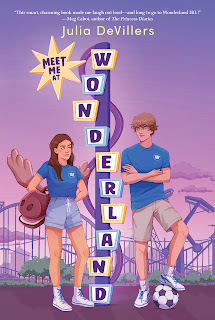
Welcome to Smack Dab, Julia! Meet Me at Wonderlandfeatures a theme park setting. What brought you to writing about this setting?I’d say it’s a fantastically fun background, but it’s far more than just background!
Hi, Smack Dab! Yes, Wonderland Amusement Park ispractically a character in my book. Going to a theme park is such a core summermemory, so having Coco’s family own one so she can go behind the scenes (skipthe lines! Be there after hours! Go into the creepy basement of broken downrides and animatronics!) was fun to write.
It was actually my editor, Alyson, who came up withthat setting, while we were brainstorming. The book is inspired by my teen jobat Chuck E. Cheese (as Chuck E. Cheese) but I couldn’t set it there so shesuggested the theme park. Which was perfect.
The protagonist Coco has a deep connection to herfamily's amusement park. Does your family have a place that is similarly yours?A business, a vacation spot?
Growing up, I spent vacations at my grandparents’farm in Copake, New York. The house was filled with bookshelves and we weren’tallowed to watch TV. It was basically a book retreat! My grandmother had afriend in book publishing who would send her not only ARCs but handwrittennotes on manuscripts in progress, even as a kid I was fascinated at that littlepeek of how books were made. Now their property is a tree farm and a memorialplayground, so that’s my tiny slice of wonderland.
In the acknowledgments, you mention your own cancerbattle and how that influenced Coco's mother's storyline. What was it likeincluding such a deeply personal experience? I imagine it would have to beincredibly cathartic.
To be honest, I wasn’t sure if it would be catharticor traumatic! This was the first book I wrote since cancer, and having ahappily-ever-after romcom story was exactly the right book to write as I could“escape” as I recovered. Once I went into remission, I realized I wanted to putsomething hopeful after cancer in the book so I wrote Coco’s mom recovered andback to work as, just as I was. So you’re right, and now talking about it withyou is cathartic as well. (Thanks, SmackDab!)
Henry and Coco's "moose-cute" is such acharming and unique meet-cute. How did you come up with this concept, and wasthe Morty the Moose character inspired by any real-life mascots?
ME! I’m Chuck E. Cheese! (I also was Mr. Munch, alittle known sidekick.) So the descriptions of being in the smelly, heavycostume is truly authentic. Also, the meet-cute really happened to me–althoughI took dramatic license. I didn’t trip and knock over a table and literallyfall at a boy’s feet. But, uh, close.
I’m always so excited to come across books for thatsort of space between MG and fully YA. The romance in the book is sweet andculminates in a first kiss, which feels perfect for readers who might beexperiencing their first feelings of attraction. How do you strike the rightbalance when writing romance for this audience?
Thanks for appreciating that. Having a crush is sucha powerful universal feeling at any age, and I tried to capture the intensity.Plus I love witty banter. I actually had a focus group of teens this age whoread my manuscript and told me, brutally, if I misstepped, which helped mecapture it more authentically.
The summer setting plays an important role in thestory. What do you think makes summer such a powerful time for personal growthand transformation, especially for teenagers?
Freedom from the school routine and responsibilitiesand those pressures! Coco and Henry are both at their first job, meeting newpeople outside of their own bubbles and taking on new responsibilities, so it’sa great set up for personal growth and self-discovery. Add in sunshine and thebeach and summer vibes…
The book contains a lot of humor, particularlyaround the moose costume mishaps. Sometimes, it seems serious topics just land better when they come with humor.Do you find that to be true as well?
That was my goal! And how I try to live my life nowas well as how I actually lived my life for that brief but potent (literallyand figuratively) time as a mascot.
The story deals with themes of family legacy,change, and finding identity beyond what's expected. Kind of that first bigstep away from childhood toward being your own person. What message do you hopeyoung readers take away most fromCoco's journey?
It’s okay to step outside of the expectations otherpeople have of you and create your own path forward. Be true to yourself andfind people who support you and cheer you on along the way. Coco and Henryaren’t only crushes, but they developed a friendship that turns from rivals tosupport systems.
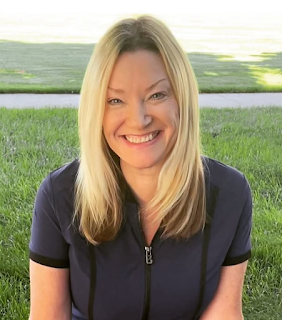
Where can we find you?
On Instagram and TikTok @juliadevillers, andhopefully visiting bookstores near you!
What’s next?
Ooh, still secret, but in progress!
Snag a copy of Meet Me at Wonderland
May 20, 2025
Interview with Catharina Steel, Author of Vanishings
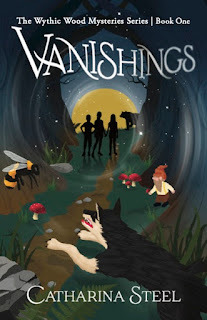
Welcometo Smack Dab, Catharina! Please tell us about Vanishings: The Wythic WoodMysteries Series | Book One.
Michaeldisappeared from Wythic Wood a year ago, and he’s still missing. Convinced thatno one’s searching for him, Tilly decides to spend the summer with Opa, theirfamily’s magical teacher and wizard, at his home in Clayton Forest—right nextto Wythic Wood.
In Clayton Forest,with cousins, Jess and Zach, Tilly meets magical beings like fairies andgnomes, gets lessons in magic, and a goblin style of martial arts calledGobight, and discovers her own magic. But her real goal calls to her and sheembarks on a perilous journey to uncover the truth about Michael’s vanishing.But impulsive Tilly doesn’t think ahead—and she and her cousins are hunted bythe Witch of Wythic Wood and the creatures under her command.
I lovethe worldbuilding here! You’ve got so many fantastic magical creatures:fairies, gnomes, goblins, etc. Do you have a favorite among all thesecreatures?
Mort, the goblin,is one of my favorites. He’s brave, kind, and cares deeply about his friends.It had fun figuring out how to write the training scene because I had topicture this quite clearly in my mind and consider how it would play out—withthe goblins longer arms and their sharp fingernails and toenails.
I also can’t helpbut adore Wilber, the kid gnome. He’s sweet and keen to be a part of the group.I enjoyed writing about the mischievous nature of gnomes. (I’ve a side storybubbling away in my head.)
How didyou go about crafting the “rules” of your magical world? And where did thoseamazing magical homes spring from? (They felt a bit fairy-tale to me, which Iloved.)
In the beginning,I was guided by the books I have read. As I grew more familiar with this worldI was creating, I began to see the rules. It’s a rather strange experiencebecause I feel like this story was given to me to write, and the rules werealready formed, I simply needed to learn them.
I love that youthink the magical homes are amazing. These homes were the first aspect of theworld I pictured—before I even thought about writing a story. One of myinterests, since I was about nine, is architecture. When I visualized thesemagical creature homes located in a forest, I knew I had something special.
The blackknee-high boot was inspired by the story “There Was an Old Woman Who Lived in aShoe” by Jane Cabrera.
The twin-mushroomhouse came from my memories of reading Enid Blyton books and how I built onthis as a young girl.
The fairy’s homemade within the trunk of a tree came from various images I’ve seen over theyears and the essence of this memory stuck with me. I pictured fairy citieswithin the treetops—those fairy-lights the lights of all the homes.
The forts corner“rock” towers and the central “castle” were inspired by a family trip as achild in Germany where we visited several old castles. The rows of fir treesthat form the walls, with a tree-walk strung between them came from a treetopwalk I’d been on.
Whatmade you decide to focus on the search for a missing family member?
This felt naturalto the story, especially as I developed Tilly’s back story more. I wondered“What would be the reason that Tilly would insist on staying at Opa’s for thesummer?” and also “What would be a strong enough pull for her to venture intothe dangerous Wythic Woods?”
I could have gonewith something like her seeing a magical stone in a vision, and have it speakto her. But with her family’s backstory, it makes sense that her drive would bethe need to keep everyone in her life safe—so they don’t leave her like herparents did (with the car crash). I think it’s good to follow your instinctswhen writing, particularly while drafting it, but question everything during anedit. Should this stay in? Why this person? Why this instigator? (Editruthlessly!)
How didyou come up with the character of Opa, who manages to bridge both the human andmagical worlds?
I first imaginedthe world of The Wythic Wood Mysteries Series so, I’d subconsciously alreadyestablished some rules before I began developing the characters. When I beganwriting about Opa (Dutch word for grandpa), there were already some surroundingfactors which helped form who he is, but it wasn’t until I wrote his originstory that I felt like I had “gotten to know him” and was able to round out hischaracter better. I don’t mention his actual name in Vanishings, but it’s PietAncilock. You can read his origin story in my novella “Magical Piet,” which isa free ebook download when people sign up for my newsletter—I’ve a subscriptionform on my website.
When I was draftingthe story, I wanted a wise wizard to guide the children in the magical world—andI wanted it to be a family member as well. (I ended up putting together afamily tree so that I had a clear picture of it.) I wanted this wizard to be aperson who understood both the human, non-magical world, as well as the magicalone. I liked the idea of him allowing the children to experience the magicalworld within the safety of his property, Clayton Forest, where they learn fromthe creatures who have sought refuge on his property—before they set off intothe Wythic Woods.
I lovea complex antagonist–and is the Witch ever complex! Can you speak a bit aboutcrafting really worthy antagonists?
This wasn’tsomething that came naturally to me since. I wrote out all the complexities ofeach character, including the Witch of Wythic Wood (the Witch).
With the Witch Iwanted to explore how a person could be warped by a traumatic experience, ifthey let it. I wanted to show how this could negatively impact on a person witha visual representation, so this is the base for how I began to develop her.
Each time I workedon editing the story, I worked on drawing her out more. I didn’t write thescenes with her in them until I did a major rewrite, but I had also developed abetter understanding of who she was by this time. This was when I began enjoyingwriting about who she was and what her world was like.
Making her petcrow able to communicate with her, which fit in well with her ability totelepathically speak with animals—a common witchy ability in this series,enabled me to more fully explore who she was and I believe this adds depth tothese scenes.
Thisbook focuses quite a bit on deception and truth. Why did you come to a magicalworld to explore that theme?
I love reading andwriting in magical worlds because it opens up so much scope to explore manytopics. In this story I raise the issue of Jess being bullied and her resultingstruggle with anxiety, Tilly’s tendency to act without planning, howdifferences from one person to the next makes life interesting, and the truthof why we each tend do what we do.
Fantasy storiestend to have intrigue at some level. In Vanishings you have the Witch who issearching for something, and you get the hint that she is working with an elf.(I reveal more about the dynamics of this particular relationship in the nextbook.)
My favorite genresto read are adventure and/or mystery stories set in magical worlds. However, Ihonestly feel like this story was “given” to me to write. There were times thatthe story flowed from me without me knowing where it was coming from. I’m aspeed typist, so the words appeared on the screen before me faster than I couldregister the thoughts, and it felt like I was reading the story as I wroteit—both a wonderful and mind-boggling experience. For me, it felt the mostnatural way to tell this story.
Theconcept of being bound or transformed against a character’s will appearsseveral times—Tilly's bound magic, the weredogs' inability to return to humanform, and the captivity of Michael and Clayton. Readers at this age are kind ofbound, in a way–bound by their youth, and the struggle for independence (it wasa metaphor I kept coming back to as I read). What do you hope young readerstake from this concept?
There will alwaysbe barriers to achieving certain things—even for us adults. Good and bad thingswill happen over the course of our lives, but it’s what we make of these things,that will either hinder or help us.
I have combinedthis “bound” concept with showing the young readers the benefits of working asa team, as well as how planning and learning what you need to learn, allcontribute to helping each of us overcome limitations.
I hope to showyoung readers that it’s perfectly acceptable to ask for help when you need it. Forexample, I hope that, if a young reader is being bullied, that they will feelmore comfortable reaching out for help.
I also like thatthey don’t first succeed in rescuing Michael, and end up saving Claytoninstead. I feel like this shows that what we first thought we wanted can workout to be so much bigger—and better.
I have so manyhopes for young people who read my story. I want to lift them up so they know theyare great just as they are. I hope to give them the courage to look around themto see who could help them. I know how hard it can be for young people to reachout for help, and sometimes they don’t feel heard, so I hope to encourage themto keep trying until they find the right person who can help them. I hope theykeep believing in themselves.
What’snext? This is book 1, so what can we expect from future installments? Do youhave a certain number of books in mind?
I’ve drafted theseries, so I can say there are four books in total. I also have several sidestories I want to write.
Books two to fourworking titles
Book Two WorkingTitle: Weredog Curse.
We leave off inVanishings with a question mark over the scratch and bite Tilly received fromtwo weredogs. We are unsure if the binding of her magic is also binding theweredog magic from effecting her, or if she simply hasn’t been affected. Thenthere’s Tippi, a weredog who has switched to their side, but is unable tochange back into her human form. These two problems become Tilly’s nextpriority as she searches for information that could help both Tippi and herself,during her next school break.
Book Three WorkingTitle: Ancient Magic
Clayton has beenmumbling about elves in his sleep. This instalment begins a search to see ifthey can locate the elves Clayton eventually tells them about, and the truthabout the Witch’s goal is revealed.
Book Four WorkingTitle: Elven Battle
I don’t want togive too much away, but things are coming to a head and they can’t see any wayaround it. The evil elf must be stopped—at all costs!
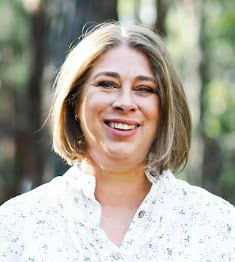
Wherecan we find you?
Website: www.catharinasteel.com
Substack: https://cathsteel.substack.com/
Instagram:https://www.instagram.com/catharina_steel_author/
May 19, 2025
Exploratory Writing to Reveal Characters and the World (Catharina Steel)
Even with the story ideaswirling around in your head, you can rarely see everything, including who thecharacters are. This is where exploratory writing comes in.
Exploring the story idea.When I think about beinga panster, I think of the writer writing by the seat of their pants and followingtheir nose to wherever the story goes!
Exploratory writing issimilar to panster writing in that I start writing the story, focusing on thescenes I’ve visualized in my mind, which aren’t necessarily sequential.
While I’m exploringthe story through writing, I’m focused on the overall story arc as I familiarizemyself with the world and how the story fits into this. And I’m getting to knowwho the characters are and what their roles in the story will be.
The characters reveal themselvesAs I discover thestory elements during this stage, it often feels like the character takes on alife of their own—dictating who they are and what they’re about—while I explorethe story, allowing it to flow from what I’ve imagined and fall where it will.This style of writing allows a story to evolve naturally—and is why it feelslike the characters reveal themselves.
Another way to look atthis is that it’s like meeting someone (the character) for the first time andthen getting to know them better the more time you spend with them (work on thestory).
Outlining and notesWriting the basics ofthe story gives me the material I need to draft the outline, characterinformation sheet, and the story’s world details sheet including map/s. Ireview this material and note different parts to the story—identifying how manybooks in the series.
I create an excelworkbook with separate outline worksheets for each book in the series. I add summariesof the exploratory scenes, as relevant to the outline, and identify the additionalscenes to be drafted. Initially, this is a loose guide so I’ve room to move asI draft the story and more elements are revealed.
Switching to Scrivener,the software I use, I create a new file for the series and pull the exploratorywriting into the various scenes according to the book outlines.
Back in my excelworkbook, I add detailed information about my characters. I have questionslisted and I use what I’ve written to start answering these. As I’m working onthis, I make decisions about the characters and edit these responses throughoutthe writing process until I’m satisfied the character has been fully formed.
I also work on theworld’s worksheet and create a basic map or maps.
I’m now ready to draftmy story!
Drafting revelationsDuring the draftingprocess, I will discover new information about the characters, the world, andthe story, so I add this to my excel workbook as I go.
This provides a moredetailed visual snapshot of the characters—giving me a stronger sense of them.I use this information during the editing stages as I go back in and work onshowing the character’s better with each edit.
Exploring scenes from the pastSometimes it’s helpfulto explore past experiences of a character to get a better feel for who theyare now. You may end up including elements of this in a flashback, but it’s morecommon for this to be purely for facilitating a deeper understanding of thecharacter. However, I once wrote a novella when I explored a character’s past!
Magical PietI felt the need todevelop the character of Opa in Vanishings further because his influenceplays an important role in Vanishings. I ended up writing his originstory in my novella called Magical Piet.
I combined ahistorical event of the creatures with his story, which worked perfectly. Thisprovided me the scope I needed to write his character in Vanishings in amuch more convincing and knowledgeable way.
The loopThe world determines theevents that shapes the character, which in turn alters their worldview—theperspective of the world the story is told from.
The reason why I don’tseparate how I develop the world, or the characters, or the story, is becausethey are all linked. One affects the other, so you can’t look at one, without factoringin the other story elements.
Consider your ownlife—the good and the bad experiences you’ve had, and how each of these momentshas shaped you into who you are today. The way you perceive yourself and whereyou fit into the world around you, and how you view the world and how youperceive everyone else, has been influenced by each and everything you haveexperienced up until this moment in your life. You don’t view your life asseparate from the world or your story—it is always seen as a whole.
Drawing the character outWith my understandingthat the world we live in will influence who we become as a person, I know thatI need to consider how the story’s world is influencing my characters.
So, while I initiallyallow my characters to reveal who they are during the exploratory writing anddrafting stages, I continue to work on them while editing—gradually getting abetter feel for each character, making it easier to determine how they will respondin each moment.

Catharina Steel Bio
First generationAustralian, Catharina Steel is the daughter of Dutch and Friesian-Dutchparents. Her writing reflects her passion for the great outdoors, wholistichealth, fantasy adventure reads, and her interest in traveling and learningabout other cultures. She believes in showing kindness to others and taking aninterest in their differences as she knows all too well how it feels to be anoutsider. Vanishings, The Wythic Wood Mysteries Series | Book One is herdebut novel.
The ebook of hernovella Magical Piet is available for free when you sign up to my 7@7with Catharina Steel author newsletter on my website:www.catharinasteel.com.
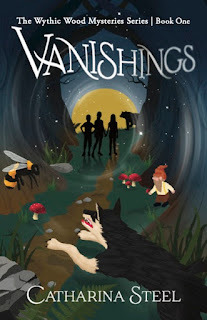
Tune in tomorrow with an interview with Catharina regarding her book Vanishings!
May 15, 2025
History Gives Us Wings!
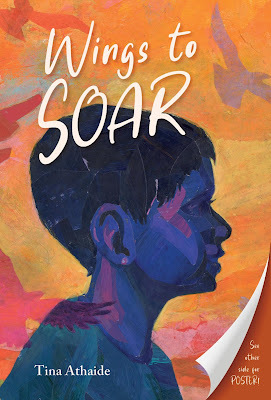
You mayrecall in my last post, I admitted that I do not write poetry. But every writerworth their salt and pepper reads and studies the mechanics ofpoetry. And I discussed Heidi Stemple’s The Poetry of CarMechanics, offering some ideas on why should writers study poetry.
This week I look at another treasure as I discuss a topicnear and dear to my own writing. Historical fiction.
“We are not makers of history. We are made by history.” -- Martin Luther King, Jr. (Strength to Love. Harper & Row, 1963.)
Why should teachers teach historical fiction?
History is more than dates. History is people, too. In thebest of historical fiction, as with any story, a child becomes a hero who gainspower over her situation, a theme that contemporary readers appreciate.
Stories make us more human. Stories allow a child tonavigate complex emotions, looking at diverse perspectives, and learning toleverage relationships for collaboration and progress. Historical fiction “… helpsyoung readers develop a feeling for a living past, illustrating the continuityof life,” says Karen Cushman, master writer of historical fiction. Historicalfiction, “like all good history, demonstrates how history is made up of thedecisions and actions of individuals and that the future will be made up of ourdecisions and actions.”
Historical fiction introduces readers to different points ofview. Reading different perspectives canbuild a reader’s “emotional sensitivity.” As Amy von Heyking (ScholasticCanada) says, “their moral and social awareness grows as they consider reasonsfor people’s behavior in other times, other places or specific situations.”Such stories provide the “insider’s perspective,” allowing readers to reach anew, deeper understanding of the other’s experience.
Tina Athaide and her Wings To Soar!
Tina Athaide’s book, Wings To Soar (Charlesbridge Moves,2024) is a middle-grade novel told in verse about a girl's resiliency whenfaced with hatred towards refugees. Set during the turbulent reign of themilitary officer and authoritarian Ugandan president Idi Amin in 1972, the story is set against the backdrop of therefugee crisis of the Ugandan Asians. Vivaand her Goan Indian family have been expelled from Uganda and sent to aresettlement camp in England. Theirfather has yet to join them. As the family waits for him, all the whiledreaming of a new home, Viva struggles to make the best of their lifeunderscored by racism, alienation, and upheaval, discovering “little cups of happiness.” Using firstperson and present tense, Viva stands out as a compelling character whounabashedly says what she believes. Readers will connect to Viva on a deeplyemotional level, bearing witness to Viva’s perseverance during the darkestmoments. And in her determination, the reader finds hope.
For a video that celebrates Wings to Soar:
An excellent interview conducted by Valerie Bolling of Kidlit in Color, inwhich Tina talks about her process in writing this book:
"Wings to Soar is more than a story—it's a healing gift to “little Tina,” a way to process the early childhood experiences that shaped my life. The decision to write this novel in verse, with white space on the pages, is deliberate; it mirrors the pauses, the breaths, and the moments of silence that are so much a part of navigating trauma and uncertainty." -- Tina Athaide
For more information about Tina and her books, visit herwebsite here: https://www.tinaathaide.com/
Be sure to pick up her book, Wings to Soar, at your favorite bookstore!
Thank you for reading!
-- Bobbi Miller
May 13, 2025
Interview with Mima Tipper, Author of Kat's Greek Summer
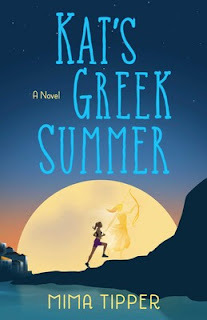 Welcometo Smack Dab, Mima! Tell us a bit about Kat’s Greek Summer.
Welcometo Smack Dab, Mima! Tell us a bit about Kat’s Greek Summer. Thanksso much for the kind welcome! I’ve got to tell you: I read through all of yourquestions before starting the interview, and I’m so psyched at the depth andvariety of the threads/topics you picked from the book.
And so,about the book: Kat’s Greek Summer is about a fourteen-year-old girl whorisks all for family, first love and self-truth over one sun-drenched Greeksummer.
A little more: soon to be high school freshman Kat Baker is all about training for thecross-country team this summer. Then her Greek mom knocks her off-course bydragging her to Greece. To meet the family. How can a girl train inninety-billion degrees? And with a sharp-eyed yiayiá watching her everymove? Determined to keep her running dream alive,
Iwas so excited to see a book about a girl in this age range (14). It’s sooverlooked—that strange area between MG and YA. Why did you gravitate towardwriting for this group?
I don’tthink I gravitated toward writing for this age group as much as to writingabout a young character at a pivotal time in her young life, ready to make ahuge transition. I see the move from middle to high school as just such a place.I have a lot of memories and feelings about that time in my own life, andwanted to reflect and imagine on that time for this story.
Thejourney of cultural identity is central to the novel. How much of your ownexperience influenced Kat's character and her struggle to connect with herGreek heritage?
Myoriginal plan was not to focus so much on the cultural identity struggle in thestory. I was thinking more general, as in “fish out of water.” Only as I wrote,so many memories and feelings about my own half Greek half American childhoodsurfaced, and my character Kat started asking some very pointed questions.Questions that had me digging very deeply into my own childhood struggle withmy two cultures. A lot of what I found in my memories and my feelings ended upin the novel.
Thesetting of Paralia is vividly portrayed throughout the novel. Is this fishingvillage based on a real place in Greece that you've visited? Any tips formaking a physical location so real on the page?
Paraliais based on my memories of the Greek fishing village where I spent my childhoodsummers. That village is called Alepahori, and it has changed a lot since I wasyoung so I didn’t want to use it as an actual location in the novel. I knowthere are still many villages and communities in Greece that are very rustic,and I wanted to capture that feeling for this book. The word “paralia” means“beach” in Greek, and it’s such a musical word; I figured that was a good namefor my fictional village. As far as making a physical location real on thepage, I always try to use locations in my stories of places I’ve visited,whether a town, a house, or and apple orchard. Sometimes I visit the placeagain, and take copious notes. Whether I am able to visit again, or whether Isimply have to remember, I spend a lot of time thinking of sensory feelings anddetails from those memories, and then imagine my characters experiencing thosesensory feelings and details.
Howdid you approach writing the romance between Kat and Theofilus for a youngeraudience? The relationship feels authentic and age-appropriate while stillcapturing the intensity of first love.
I adoreromance stories, always have, and wanted a romantic thread for Kat. Theofilusis very loosely based on a Greek boy I met during my 15th summer,and I had a lot of fun thinking of that time and remembering my feelings aroundthat crush, as well as crushes when even younger. I don’t know about other children’sor YA writers, but I think part of the reason I gravitate toward stories ofchildren and teens is that I have very vivid memories of my childhood and teenfeelings. I also have three children, so had a front row seat fairly recentlyto their early teen years.
Runningserves as both a literal and metaphorical journey for Kat. What inspired you tomake this activity so central to her character development?
When Ibegan to envision Kat, I wanted her to be as opposite to me at that age aspossible. With that in mind, I wanted to create a character who knows highschool is going to be a big change and a big opportunity for change, and beproactive about her desire to find a place and fit in. When my own kids werestarting high school, there was thinking and advice around choosing to be partof an athletic team because then freshmen were invited to come to the“pre-season” before school started—a good time to make friends, etc. Thatseemed exactly what would strike Kat, and cross country seemed perfect becauseat least in Vermont anyone is welcome to join as opposed to the morecompetitive teams. And from my own kids’ experience, the cross-country runnersgenerally have trainings all summer.
Theofilus'sartistic talents and dreams are really almost a complete opposite to Kat'srunning. Was there a particular reason you chose art as his passion?
As Iimagined Theofilus, I knew he had to be a relative outsider to the village, andthat he had to have compelling motivation to behave as he does through thebook. Having him be an artist was also physically possible because art is anactivity that has many portable aspects, and could be done at any time, sowould work with his fishing/boat duties. I also thought that both he and Kathaving strong and personal passions would give them a very natural connectionpoint.
Howdid you decide which cultural elements to include (food, mythology, etc.)?
Oh, my,that’s a huge question. Many of those cultural elements came through little bylittle through all of my drafting. The food is all food that my own Greek yiayiácooked for me during my own Greek summers. And I am a huge and lifelongGreek mythology fan. The original title of the book was “Greek God Summer” and backin those versions every chapter was Kat battling or experiencing somethingGreek mythology related. I’d have to go way back in my files to find one ofthose early drafts, but an example would be something like “Chapter One, Hermesbrings a message”. Those chapter headings didn’t last, but the goddess Artemisplayed into some of the headings, and I found that Kat just kept looking toArtemis, kind of like a secret friend.
Thenovel ends with Kat embracing possibilities rather than with everything neatlyresolved. The ambiguous ending is so tough to write! How did you navigate itwhile also giving the book a satisfying conclusion?
Thanksso much for saying that about my ending. As one of the themes of the book isclaiming your “self” and your heritage, it was important to me that part ofKat’s journey is to understand how getting to the “top” or the “end” ofsomething is not the actual top or end. That there’s always more. In that way,it made sense for her to reach one big goal, but that part of reaching thatgoal was to understand that there would be many, many more on her horizon.
What’snext?
I justsigned a contract for my next book which will come out in the summer of 2026,and it is a contemporary paranormal YA. I’m pretty focused on Kat’s GreekSummer right now, of course, but I’ll be posting about my next book on mywebsite and on social media soon, so stay tuned.
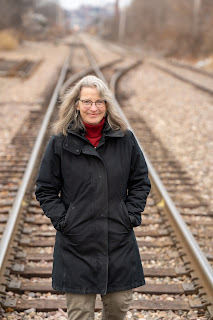
Where can we find you?
https://facebook.com/mimatipper
https://mimatipper.substack.com
May 12, 2025
Book Review: ISLE OF EVER by Jen Calonita
I recently read an interesting and engaging middle grade book from author JEN CALONITA. ISLE OF EVER is the first book in a new series about a lost island, time travel, treasure, riddles, mystery. In other words, it's a book that has it all and will likely appeal to the middle grade population.
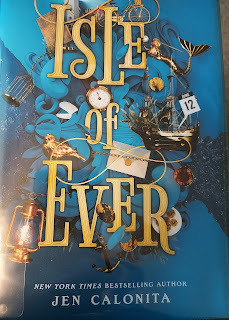
Two hundred years ago, an island disappeared. Benny has just two weeks to find it.
Everly "Benny" Benedict and her mom have always managed to get by, though they're broke most of the time. But all that could change. Benny's just learned she's the sole heir to the vast fortune of Evelyn Terry, a mysterious ancestor from the 1800s!
There's a catch, though. First Benny needs to play―and win―a game: following clues that are more than a century old, she must find her way to the tiny island Evelyn wrote about in her diary. It was somewhere off the shoreline of Evelyn's home town, but according to legend, it vanished long ago and hasn't appeared on maps for hundreds of years. Yet Benny has only a couple weeks to locate it.
If she's successful, she'll collect the inheritance. But what if there's more than a fortune at stake in this game? What if Benny has to break an ancient curse to win?
Here's my review:
ISLE OF EVER by Jen Calonita
This engaging and riveting book has it all. History,adventure, mystery, puzzles, a hint of danger, a mysterious mansion, and aburied treasure. Also an island that seems to only appear every 200 years! IfBenny can solve the clues left by an ancient ancestor, she will inherit afortune and save her and her mom from poverty. All the riches left by greatgreat great great grandma Evelyn will behers. If she can solve the riddles in 13 days. This is the first book in a newseries that kids are going to love.
Darlene Beck Jacobson loves a good adventure, especially when it involves history, puzzles, and a bit of mystery. She imagines and writes her own adventures in NJ.



